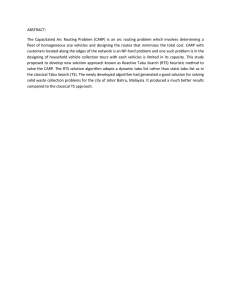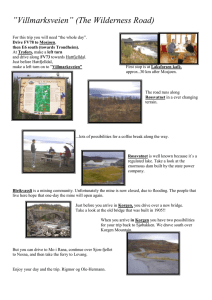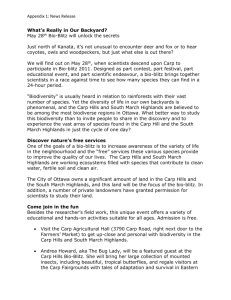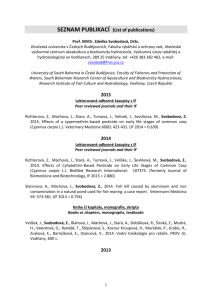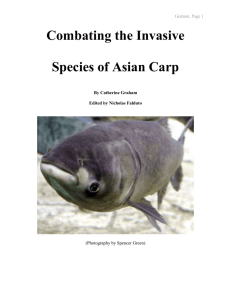Heuristics and Lower Bound for the
advertisement
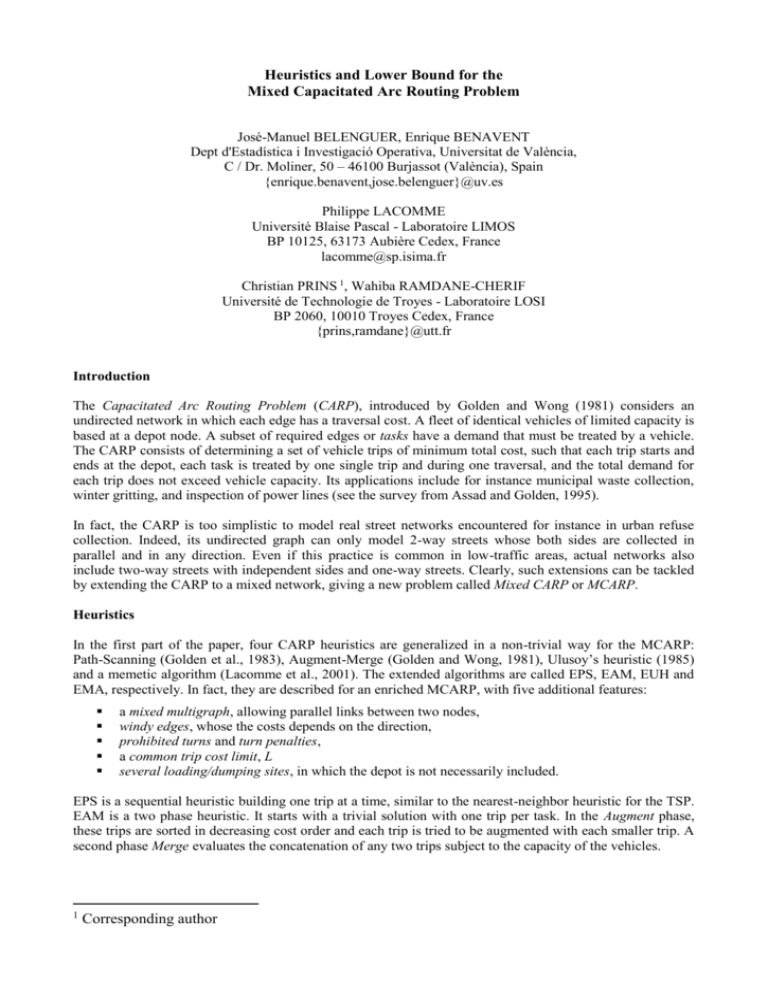
Heuristics and Lower Bound for the
Mixed Capacitated Arc Routing Problem
José-Manuel BELENGUER, Enrique BENAVENT
Dept d'Estadística i Investigació Operativa, Universitat de València,
C / Dr. Moliner, 50 – 46100 Burjassot (València), Spain
{enrique.benavent,jose.belenguer}@uv.es
Philippe LACOMME
Université Blaise Pascal - Laboratoire LIMOS
BP 10125, 63173 Aubière Cedex, France
lacomme@sp.isima.fr
Christian PRINS 1, Wahiba RAMDANE-CHERIF
Université de Technologie de Troyes - Laboratoire LOSI
BP 2060, 10010 Troyes Cedex, France
{prins,ramdane}@utt.fr
Introduction
The Capacitated Arc Routing Problem (CARP), introduced by Golden and Wong (1981) considers an
undirected network in which each edge has a traversal cost. A fleet of identical vehicles of limited capacity is
based at a depot node. A subset of required edges or tasks have a demand that must be treated by a vehicle.
The CARP consists of determining a set of vehicle trips of minimum total cost, such that each trip starts and
ends at the depot, each task is treated by one single trip and during one traversal, and the total demand for
each trip does not exceed vehicle capacity. Its applications include for instance municipal waste collection,
winter gritting, and inspection of power lines (see the survey from Assad and Golden, 1995).
In fact, the CARP is too simplistic to model real street networks encountered for instance in urban refuse
collection. Indeed, its undirected graph can only model 2-way streets whose both sides are collected in
parallel and in any direction. Even if this practice is common in low-traffic areas, actual networks also
include two-way streets with independent sides and one-way streets. Clearly, such extensions can be tackled
by extending the CARP to a mixed network, giving a new problem called Mixed CARP or MCARP.
Heuristics
In the first part of the paper, four CARP heuristics are generalized in a non-trivial way for the MCARP:
Path-Scanning (Golden et al., 1983), Augment-Merge (Golden and Wong, 1981), Ulusoy’s heuristic (1985)
and a memetic algorithm (Lacomme et al., 2001). The extended algorithms are called EPS, EAM, EUH and
EMA, respectively. In fact, they are described for an enriched MCARP, with five additional features:
a mixed multigraph, allowing parallel links between two nodes,
windy edges, whose the costs depends on the direction,
prohibited turns and turn penalties,
a common trip cost limit, L
several loading/dumping sites, in which the depot is not necessarily included.
EPS is a sequential heuristic building one trip at a time, similar to the nearest-neighbor heuristic for the TSP.
EAM is a two phase heuristic. It starts with a trivial solution with one trip per task. In the Augment phase,
these trips are sorted in decreasing cost order and each trip is tried to be augmented with each smaller trip. A
second phase Merge evaluates the concatenation of any two trips subject to the capacity of the vehicles.
1
Corresponding author
The extended Ulusoy's heuristic (EUH) temporarily relaxes vehicle capacity Q and trip cost limit L to
compute a least-cost giant tour S covering the tasks. In fact, this windy mixed rural postman problem is
solved approximately, by calling EPS and with huge values for Q and L. This tour is split into capacityfeasible trips by a procedure Split . This procedure breaks the tour into feasible trips in an optimal way
subject to the sequence imposed by the giant trip by solving a shortest path problem on an auxiliary graph.
The memetic algorithm (MA) is a genetic algorithm hybridised with a local search. Lacomme et al. (2001)
proposed an MA for an extended CARP with the three first extensions. After various refinements in 2002,
this MA is now one of the most efficient solution methods for the CARP. Its adaptation for the other
extensions is straightforward. The chromosome structure and the evaluation procedure are as follows. A
chromosome is a sequence S of all the tasks, without trip delimiters, in which each task occurs once. S may
be viewed as a “giant tour” treating all tasks and performed by one single vehicle of infinite capacity. The
optimal MCARP solution (subject to this order) is computed by the Split procedure mentioned above.
Thanks to chromosomes without trip delimiters, standard crossovers designed for sequencing problems like
the TSP (e.g., OX and LOX) can be applied to generate children that can be optimally evaluated by the
splitting procedure.
Cutting plane algorithm
We also present a cutting plane algorithm to obtain a lower bound for the basic MCARP, that is, without the
extensions mentioned above. The method is based on the work of Belenguer and Benavent (2003) for the
CARP, and the formulation used by Nobert and Picard (1996) for the Mixed Chinese Postman Problem.
Nobert and Picard introduced the so called Balance Constraints that allow to formulate the MCPP with only
one variable per edge and arc. This makes the formulation more compact and, probably, more tight. The
resulting cutting plane algorithm compute tight lower bounds for the MCARP.
Computational experience
Finally, the lower bounds and the heuristics are compared on two sets of randomly generated instances: 34
medium-scale instances with 43-138 required links, called mval instances, that were generated from the
classic instances for the CARP introduced by Benavent et al. (1992), and 15 large-scale ones with 50-806
required links, called lpr instances, that were randomly generated trying to resemble the street network of a
city. 24 proven optima were obtained on the mval instances with average deviation to the lower bound of
only 0.51%. On the lpr instances, the results were 6 optima found and an average deviation of 0.46%. These
promising results constitute a step towards more realistic models in arc routing.
References
A.A. Assad, B.L. Golden, Arc routing methods and applications, in: M.O. Ball et al. (Eds.), Handbooks in
OR and MS Volume 8, Elsevier, Amsterdam, 1995, pp. 375-483.
J.M. Belenguer, E. Benavent, A cutting plane algorithm for the Capacitated Arc Routing Problem,
Computers and Operations Research 30(5), 2003, pp. 705-728.
E. Benavent, V. Campos, A. Corberán and E. Mota, "The Capacitated Arc Routing Problem. Lower
Bounds", Networks , 1992, 22, 669-690.
B.L. Golden, J.S. Dearmon, E.K. Baker, Computational experiments with algorithms for a class of routing
problems, Computers and Operations Research 10(1), 1983, pp. 47-59.
B.L. Golden, R.T. Wong, Capacitated arc routing problems, Networks 11, 1981, pp. 305-315.
P. Lacomme, C. Prins, W. Ramdane-Chérif, A genetic algorithm for the Capacitated Arc Routing Problem
and its extensions, in E.J.W. Boers et al. (Eds.), Applications of evolutionary computing, Lecture Notes in
Computer Science 2037, Springer, Berlin, 2001, pp. 473-483.
G. Ulusoy, The fleet size and mixed problem for the Capacitated Arc Routing Problem, Uuropean Journal of
Operational Research, 22, 1985, pp. 329-337.
